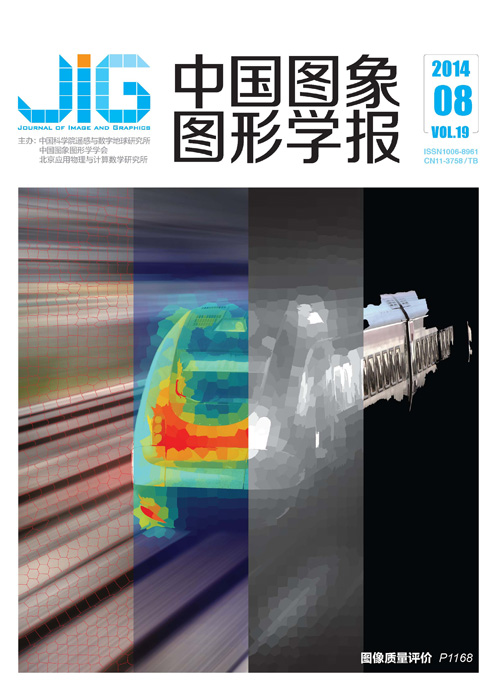
波段排序的高光谱影像3维混合树编码方法
摘 要
目的 高光谱影像压缩的关键技术是对空间维和光谱维的去相关性。根据高光谱影像数据结构的特点,如何有效去除其空间相关性与谱间相关性是高光谱影像压缩中至关重要的问题。对高光谱影像进行编码时,3维小波变换是极为有效的去除冗余的方法。因此提出了一种通过波段排序并结合3维混合树型结构对高光谱影像3维小波变换系数进行编码的算法。方法 首先,将高光谱影像按照自然波段顺序进行波段分组,并对每组影像进行相邻影像的谱间相关性统计;其次,对相关性较弱的波段组,建立以影像波段序号为顶点、影像相关性系数为边的完全图,对这个完全图求其最大汉密尔顿回路。按照求得的最大汉密尔顿回路顺序对该波段组进行重新排序,从而提高波段组的谱间相关性;在此基础上,对重新排序后的波段组进行3维小波变换,并通过3维混合树结构对3维小波变换系数进行零树编码。结果 通过对大量AVIRIS型高光谱影像数据的仿真实验,验证了本文方法的有效性。对相关性较低的波段组,加入排序算法后,其解码影像与未排序时比,峰值信噪比有了一定的提高。通过实验统计,算法平均用时2.7579s。结论 由于采用了对弱相关性波段组的重新排序机制,使得基于混合树结构的3维零树编码出现了更多有效的零树,在一定程度上提高了编码效率。通过实验统计算法用时,表明该方法以较小的时间代价获得了解码效果的提升。
关键词
Hyperspectral image coding with band ordering and 3D hybrid tree
Wang Xianghai1,2, Xie Tian1, Song Chuanming1, Zhang Zhidi1(1.College of Computer and Information Technology, Liaoning Normal University, Dalian 116029, China;2.Liaoning Key Laboratory of Physical Geography and Geomatics, Liaoig Normal University, Dalian 116029, China) Abstract
Objective The key technology in hyperspectral remote sensing image compressiom is to get rid of the spatial correlation and spectral correlation. According to the characteristics of the structure of data of hyperspectral remote sensing image, how to effectively remove the spatial correlation and spectral correlation in hyperspectral image compression is a crucial problem. For hyperspectral remote sensing image, in the image coding, wavelet transform is a very effective method to remove redundancy. 3D wavelet transform can effectively remove the spatial correlation and spectral correlation of hyperspectral image. Therefore, this paper proposes a coding algorithm based on band ordering and 3D hybrid tree. Method First, the hyperspectral remote sensing image is divided into groups based on natural spectral order, each group contains 16 continuous spectral bands. Second, in each band group, the sum of the spectral correlation of all the adjacent bands is calculated. If the correlation value is less than a given threshold, a complete graph is structured on the basis of the group of bands. In the complete graph, each apex represents a band, so there are 16 apexes in the graph, and each side of the complete graph represents the spectral correlation value of two bands in the group. Then, the max Hamilton loop of the complete graph is searched for, and the group of bangs is reorderd based on the max Hamilton order to improve the correlation value of the band group. On the basis of the above, the reordered group of bands is given a 3D wavelet transform, and 3D hybrid tree coding algorithm is used to encoded the 3D wavelet transform coefficients. As to those band groups whose sum correlation values are greater than the given threshold, their band order does not have to be reordered. 3D wavelet transform will be given to these band groups directly, and then wavelet transform coefficients will be encoded by the 3D hybrid tree coding algorithm. Result First, reordering the band groups with a relatively small correlation value can improve the efficiency of 3D wavelet transform in removing the spectral correlation and spatial correlation of hyperspectral image. By reordering, 3D wavelet can more effectively remove the redundancy. Second, the use of 3D hybrid tree coding algorithm can produce more effective zero trees because the group of band with a weak correlation value is reordered to improve the correlation value. Based on the algorithm above, the coding efficiency improves to a certain extent. Conclusion AVIRIS hyperspectral images are used in the simulation experiment to verify the validity of the algorithm. Given the adoption of a reordering mechanism on the band groups that have weak spectral correlation values, the hybrid tree structure of the 3D zero tree coding algorithm appears more effective and to a certain extent, improve the coding efficiency. From the experimental data we can see that, compared with the use of wavelet transform only, joined band ordering and the hybrid tree structure coding algorithm improves the peak signal-to-noise ratio of the decoded image to some extent.
Keywords
|



 中国图象图形学报 │ 京ICP备05080539号-4 │ 本系统由
中国图象图形学报 │ 京ICP备05080539号-4 │ 本系统由